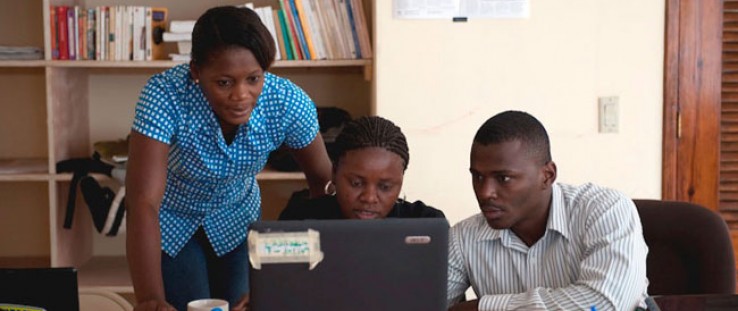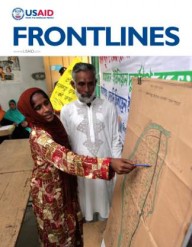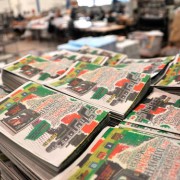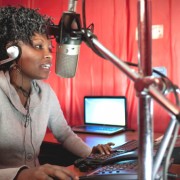 ENDK journalist Witza Petit Antoine is flanked by Internews researchers Louisena Louis, left, and Franck Lafont as they sort SMS received for ENDK “Mailbox” segment.
Charles Eckert
ENDK journalist Witza Petit Antoine is flanked by Internews researchers Louisena Louis, left, and Franck Lafont as they sort SMS received for ENDK “Mailbox” segment.
Charles Eckert
 ENDK journalist Witza Petit Antoine is flanked by Internews researchers Louisena Louis, left, and Franck Lafont as they sort SMS received for ENDK “Mailbox” segment.
Charles Eckert
ENDK journalist Witza Petit Antoine is flanked by Internews researchers Louisena Louis, left, and Franck Lafont as they sort SMS received for ENDK “Mailbox” segment.
Charles Eckert
When the powerful 7.0 magnitude earthquake shook Haiti on Jan. 12, 2010, resulting in more than 230,000 deaths and at least 300,000 injuries in the country’s capital, Port-au-Prince, communications infrastructure went critical.
Nearly 50 stations in the capital and many others in the surrounding areas were knocked off the air. Several were reduced to rubble. Radio stations Radio One and Signal FM were the only broadcasters on air in Port-au-Prince for several days after the earthquake. In a country where radio is one of the most ubiquitous and reliable news sources, the broadcast silence was deafening.
Help arrived through the international media development non-profitInternews and its USAID-supported radio program called Enfòmasyon Nou Dwe Konnen (ENDK), meaning “Information You Need to Know” in Creole, and dubbed “News You Can Use” in English. As stations returned to the airwaves, the program aired on 40 local stations at its peak.
While other groups distributed food, water and medicine to survivors, ENDK distributed something just as critical: information about where and how to access those life-saving services.
Produced by a team of 12 Haitian journalists, the radio program focused on accurate, timely and well-targeted information like how to get in touch with missing relatives, where to access food, water and health care, and who to contact to replace lost identification papers. The broadcasts also provided practical hygiene and health tips, and useful guidelines for protecting a tent from flooding and tropical winds.
The 20-minute daily humanitarian radio program was produced at an emergency newsroom set up in Port-au-Prince with assistance from Haitian and international trainers. By 7 p.m. each evening, the latest radio program was copied onto CDs and delivered by motorcycle to stations in Port-au-Prince.
“ENDK was a real hit from day one. We could hear the radio show everywhere, all the time. In the first few days, some radio stations would play it four to five times a day as it was their only source of news and information on emergency relief. And our Haitian colleagues would come back every day to the newsroom saying how much people listen to the program. They were helping their own people and they were really proud,” said Philippe Allouard, Internews country director in Haiti and a member of the emergency response team.
ENDK first aired on Jan. 21, 2010, and ran until May 18, 2012, Haiti’s Flag Day. There were 615 editions, not counting weekly “best of” broadcasts and monthly magazines. Researchers found as many as 65 percent of surveyed Haitians knew of the program within a few months of its launch.
“Nobody would like to miss an edition of ENDK. It’s a very useful program and so we seek for it every day,” said Bernard, a resident from the Champ de Mars camp, a few months after the earthquake. His last name has been withheld for privacy reasons.
While access to radio was very high in Port-au-Prince, the U.S. Government also donated 10,000 wind-up radios, equipped with a flashlight, small solar panel and USB mobile phone charger.
“At ENDK, I was mostly in the newsroom, revising the scripts before our presenters to record in our cardboard-made studio booth. Since I was sleeping in a church yard, just like the population of my entire neighborhood, it did not take long before I understood the popularity of the news program,” said Karl Foster Candio, a journalist and first local editor-in-chief of ENDK, formerly with Ticket Magazine, who worked on the program. “Each time I came back at night, the radio program was always on in our little camp. In some of the large organized camps, we later found out, the program was broadcasted through speakers.
“We also knew that the program was useful because the radio stations agreed to broadcast it without any financial conditions. In a country like Haiti, this is one of the best recognitions you can receive,” said Candio.
“ENDK was one of the first steps by USAID to give power back to people rendered helpless,” says Sinclair Cornell, senior media adviser for the Agency’s Office of Transition Initiatives. “Every person we met with in Port-au-Prince had a family member or a friend who had died or was injured in the earthquake. With buildings reduced to rubble and over a million homeless, putting information into the hands of the population was the first way families could begin to take back control of their lives. With news from ENDK, people knew where to find food, access drinking water, and send their children to re-opened schools. The residents of Port-au-Prince used ENDK information to make their own decisions again.”
A Critical Lifeline
For one listener, Gesner Estimil, the show threw him a lifeline. The 38-year-old father of three lost his wife and his right leg in the disaster.
In April 2010, Estimil heard a story produced by a newly trained ENDK journalist about a Catholic Medical Mission Board program that provided free care and prostheses to amputees. The story was broadcast on more than two dozen radio stations in the Port-au-Prince area. After hearing the segment on Radio 1, Estimil got in touch with the journalist to inquire about the prosthesis program.
Within minutes, the journalist contacted Catholic Medical Mission Board officials and secured Estimil an appointment for the next day. The specialist checked and treated the damaged leg, and a couple of months later Estimil received his new prosthesis, which allowed him to regain mobility and return to running his florist shop.
“Estimil’s story vividly illustrates the immediate impact humanitarian media can have in times of crisis. With such information, affected populations can make critical choices about their life, safety and health, while helping the livelihoods of their families and communities,” Frohardt said.
ENDK also covered Haiti’s cholera outbreak following the earthquake, teaching listeners how best to avoid the deadly disease.
Another ENDK segment covered nutritional information, such as the importance of vitamins to good health and how to obtain them by eating specific foods. Programs also aired information to help prevent malaria and diarrhea, as well as sources of antiretroviral drugs, vital information in a country with a high rate of HIV.
Despite the recognition and popularity of ENDK in Haiti, and similar formats and media interventions around the world, some argue that local media in emergency response is still a vastly underutilized resource. “Despite the progress made particularly since Haiti, historically, the humanitarian community has failed to realize that communication is one of the most powerful forms of aid,” says Jacobo Quintanilla, director of humanitarian information programs at Internews.
Still, over the past decade USAID has helped local media organizations report in major crises like the 2004 Indian Ocean tsunami as well as ongoing turmoil like the last conflict in Sri Lanka, which stretched over several years.
In addition to supporting local media as they do their job—reporting news and opening new avenues for dialogue—assistance has also helped reporters serve as a critical link between their fellow countrymen in crisis and humanitarian agencies.
As Quintanilla puts it, “Communication is aid. Effective communication with local communities helps the humanitarian community and local governments to be more transparent and more accountable to those they are mandated to assist. It does fulfill people’s right to know, ask questions and participate in their own relief and recovery. And ultimately, it does have a dramatic effect on the success of lifesaving efforts as a whole. ”











Comment
Make a general inquiry or suggest an improvement.